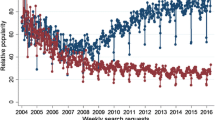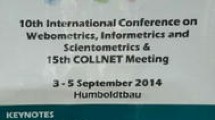Abstract
This issue ofScientometrics originated from a Workshop of the European Association for the Study of Science and Technology (EASST). In this introduction the relations between qualitative theory and the use of scientometric methods is placed in the historical perspective of the emergence of science and technology studies over the last decades. The differences among various theories in terms of dimensions, units of analysis and levels of aggregation are elaborated. Thereafter, the various contributions to the issue are discussed within this framework.
Similar content being viewed by others
Notes and references
B. C. GRIFFITH, H. D. WHITE, Authors as markers of intellectual space: Cocitation in studies of science, technology and society,Journal of Documentation, 38, No. 4 (1983) 255.
I. SPIEGEL-RÖSING, D. De SOLLA PRICE (Eds),Science, Technology and Society. A Cross-Disciplinary Perspective, Sage, London and Beverly Hills, 1977.
D. De SOLLA PRICE,Little Science, Big Science, Columbia University Press, New York, 1965.
T. S. KUHN,The Structure of Scientific Revolutions, Chicago, 1962.
D. CRANE, Social structure in a group of scientists: A test of the “Invisible College” Hypothesis,American Sociological Review, 34 No. 3 (1969) 335; B. C. GRIFFITH, N. C. MULLINS, Coherent social groups in scientific change,Science. 177 (15 September 1972) 52; J. R. COLE, S. COLE,Social Stratification in Science, Univ. of Chicago Press, Chicago/London, 1973.
H. SMALL, B. GRIFFITH, The structure of the scientific literature I,Science Studies, 4 (1974) 17.
N. C. MULLINS, L. L. HARGENS, P. K. HECHT, E. L. KICK, Group structure of cocitation clusters: A comparative study,American Sociological Review 42 (1977) 552; K. E. STUDER, D. E. CHUBIN,The Cancer Mission, Social Contexts of Biomedical Research, Sage, Beverly Hills/London, 1980.
F. NARIN,Evaluative Bibliometrics, CHI Research, Computer Horizons Inc., Cherry Hill, N. J., 1976.
See, for example, the contribution of T. LUUKKONEN to this volume. See also: H. F. MOED, W. J. M. BURGER, J. G. FRANKFORT, A. F. J. Van RAAN,On the Measurement of Research Performance: the Use of Bibliometric Indicators, Research Policy Unit, University of Leiden, Leiden 1983; A. F. J. Van RAAN (ED.),Handbook of Quantitative Studies of Science and Technology, Elsevier, Amsterdam, 1988.
S. COZZENS, Taking the measure of science: A review of citation theories,Newsletter of the International Society for the Sociology of Knowledge, 7 (1981, May) 16; S. COZZENS, ‘What do citations count? The rhetoric-first model’, this volume. See also: L. LEYDESDORFF, Toward a theory of citation,Scientometrics, 12 (1987) 305.
H. SMALL, E. SWEENEY, E. GREENLEE, Clustering the Science Citation Index using co-citations II. Mapping science,Scientometrics, 8 (1985) 321–340.
K. KNORR-CETINA,The Manufacture of Knowledge. An Essay on the Constructivist and Contextual Nature of Science, Pergamon Press, Oxford/New York, 1981.
D. C. PELZ, F. M. ANDREWS,Scientists in Organizations, Productive Climates for Research and Development, Wiley, New York, 1966, See also: K. D. KNORR, R. MITTERMEIER, Publication and professional position: Crossnational evidence on the role of organizations,Scientometrics, 2 (1980) 95.
S. B. BARNES, R. G. A. DOLBY, The scientific ethos: A deviant viewpoint,Archives européennes de sociologie, 11 (1970) 3–25.
D. BLOOR,Knowledge and Social Imagery, Routledge & Kegan Paul, London/Boston, 1976.
K. D. KNORR-CETINA, M. J. MULKAY,Science Observed, Sage, London, 1983; B. LATOUR, S. WOOLGAR,Laboratory Life, Sage, Beverly Hills, etc., 1979.
H. M. COLLINS, The sociology of scientific knowledge: Studies of contemporary science,Annual Review of Sociology, 9 (1983) 265.
K. KNORR-CETINA,The Manufacture of Knowledge. An Essay on the Constructivist and Contextual Nature of Science, Pergomon Press, Oxford/New York, 1981; B. LATOUR,Science in Action, Open University Press, Milton Keynes, 1987.
R. D. WHITLEY,The Intellectual and Social Organization of the Sciences, Oxford University Press, Oxford, 1984.
See, for example: T. PINCH, Towards an analysis of scientific observation: The externality and evidential significance of observational reports in physics,Social Studies of Science, 15 (1985) 3–36.
S. E. COZZENS (Ed.), Funding and knowledge growth, Theme issue,Social Studies of Science, 16 (1986) 3–150; L. LEYDESDORFF, P. Van der SCHAAR, The use of scientometric methods for evaluating national research programs,Science & Technology Studies, 5 (1987) 22–31.
I. SPIEGEL-RÖSING,Wissenschaftsentwicklung und Wissenschaftssteuerung, Athenäum Verlag, Frankfurt a. M., 1973, pp. 106–131; G. KÜPPERS, P. LUNDGREEN, P. WEINGART, Umweltprogramm und Umweltforschung, in: W. Van den DAELE e.a. (Eds),Geplante Forschung, Suhrkamp, Frankfurt a.M., 1979.
K. E. STUDER, D. E. CHUBIN,The Cancer Mission. Social Contexts of Biomedical Research, Sage Beverly Hills/London, 1980. pp. 269; L. LEYDESDORFF, The Development of frames of references,Scientometrics, 9 (1986) 103–125.
Cf. the ‘credibility circle’ in: B. LATOUR, S. WOOLGAR,Laboratory Life, Sage, Beverly Hills etc., 1979.
M. CALLON, J.-P. COURTIAL, W. A. TURNER, S. BAUIN, From translations to problematic networks: An introduction to co-word analysis,Social Science Information, 22 (1983) 199.; M. CALLON, J. LAW, A. RIP (Eds),Mapping the Dynamics of Science and Technology, MacMillan, Houndmills, etc., 1986.
H. M. COLLINS, The possibilites of science policy,Social Studies of Science, 15 (1985) 554.
M. HESSE,Revolutions and Reconstructions in the Philosophy of Science, Harvester Press, London, 1980.
R. S. BURT, Network data from archival records, in: R. S. BURT, M. J. MINOR (Eds),Applied Network Analysis, Beverly Hills, etc.: Sage, 1983, p. 170 f.
R. D. WHITLEY, 1984.Op. cit., note 19.
M. HESSE, 1980.Op.cit., note 27.
The term ‘unit of event’ was suggested to me byFrederyck L. Holmes, who argues that the working day should be taken as signifant unit of event for the reconstruction of the life and work ofHans Krebs.
M. E. LESK, Word-word associations in document retrieval systems,American Documentation, 20 (1969) 27; G. SALTON, M. J. McGILL,Introduction to Modern Information Retrieval, McGraw-Hill, Auckland, etc., 1983.
T. WINOGRAD,Understanding Natural Language, Academic Press, New York, 1972; Y. IJIRI, H. A. SIMON,Skew Distributions and the Sizes of Business Firms. North Holland, Amsterdam, 1977; Y.-S. CHEN,Statistical Models of Text: A System Theory Approach, Ph. D. Thesis, Purdue Univesity, 1985.
L. LEYDESDORFF, The development of frames of references,Scientometrics, 9 (1986) 103; L. LEYDESDORFF, Various methods for the mapping of science,Scientometrics, 11 (1987) 295.–324.
E. ROSKAM, J. C. LINGOES,Minissa-I, June 1974.
Because of the choice for theSocial Science Citation Index theCzech Journal of Physics is unfortunately excluded from the analysis.Minerva had to be excluded from the analysis since no ‘citing’ data for this journal are yet available in 1986.
See for the discussion of citing verus cited patterns: LEYDESDORFF, 1986.Op. cit., note 23..
Author information
Authors and Affiliations
Rights and permissions
About this article
Cite this article
Leydesdorff, L. The relations between qualitative theory and scientometric methods in science and technology studies. Scientometrics 15, 333–347 (1989). https://doi.org/10.1007/BF02017058
Received:
Issue Date:
DOI: https://doi.org/10.1007/BF02017058




